What made 1980s Madonna stand out in the crowded world of pop? She didn’t just top the charts—she reshaped them. With bold fashion, fearless lyrics, and constant reinvention, Madonna transformed pop music into a powerful cultural force, becoming the ultimate icon of a decade defined by change.
In this post, we’ll explore how she became the defining pop queen of the decade—and why her influence still matters today.
Key Takeaways
-
Madonna revolutionized pop music in the 1980s through bold fashion, fearless performances, and a constant reinvention of her image, helping her rise from New York clubs to global superstardom.
-
Her early hits and iconic music videos—including “Lucky Star,” “Material Girl,” and “La Isla Bonita”—defined a new era of dance-pop and helped shape MTV-driven pop culture.
-
Fashion was central to her impact, as she fused streetwear with high fashion, working with designers like Jean Paul Gaultier to create looks that challenged gender norms and redefined style in pop.
-
Madonna’s live performances and tours set new standards, blending music, theater, and provocative themes that influenced generations of artists and cemented her legacy as the Queen of Pop.
How Madonna Became the Queen of Pop
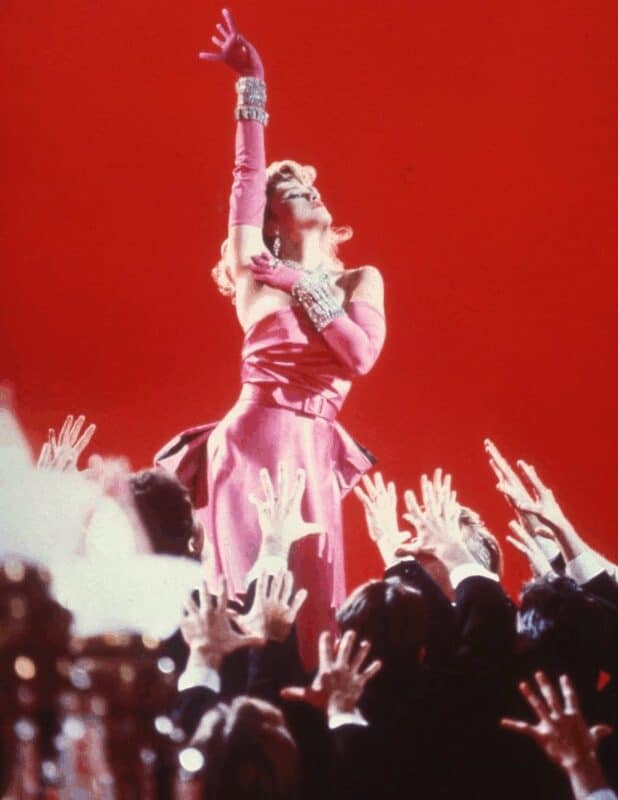
Credits: @Afaafafaffafafaffafaf / Pinterest
Madonna didn’t rise to fame by following the rules—she rewrote them. From playing small clubs in New York to commanding stadiums around the world, her journey shows how talent and sheer determination can shape a legend.
From New York Clubs to World Stages
When she moved to New York in 1978, she knew the club scene could launch her career. She worked as a dancer, played drums and guitar in local bands, and handed out demo tapes to DJs at clubs like Danceteria.
That persistence paid off when “Everybody” became a dance-floor hit, catching the ear of Sire Records executive Seymour Stein. Her debut single led to a record deal and revealed her ambition from the start—she wasn’t just chasing stardom; she was chasing dominance in pop music.
I remember hearing “Everybody” in a downtown bar—the room lit up with her energy. That was my first glimpse of her star power.
Debut Album and Early Breakouts
Madonna’s self-titled debut album dropped in July 1983 and felt like a breath of fresh air. Backed by electronic beats and bubbling synths, tracks like “Lucky Star,” “Borderline,” and “Holiday” blended pop, disco, and new wave into a style uniquely her own.
Music critics later noted the album reinvented dance-pop for Top 40 radio. Each single charted on Billboard, with “Lucky Star” hitting the top five—her first major U.S. breakthrough.
From studio to stage, she toured clubs and appeared on TV, building momentum one performance at a time.
Breakthrough Moments on American Bandstand
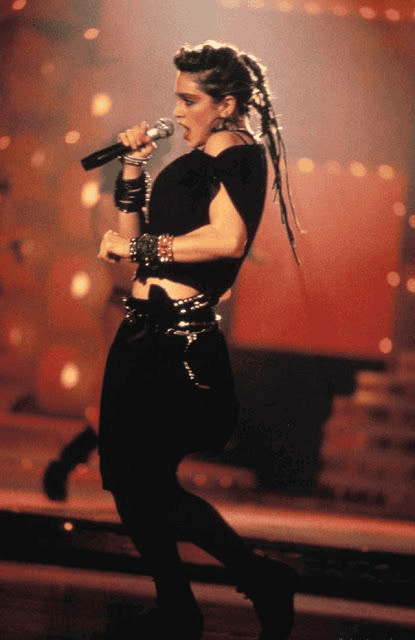
Credits: @alexmccl / Pinterest
Her debut on American Bandstand in January 1984 was a turning point. Madonna performed “Holiday” and confidently told Dick Clark she wanted to “rule the world”—a statement that left the audience stunned but excited.
That moment marked her readiness to dominate pop music and made her a national name. I remember watching that clip and thinking: this is more than a singer—it’s a queen being crowned live.
That blend of charisma and confidence became her hallmark and set her apart from every other artist on TV or the radio.
Madonna’s rise from the club floors of New York to the global stage wasn’t about luck. It was about making bold moves—dropping debut albums that challenged the status quo, owning unforgettable moments on live television, and always pushing her image and sound forward.
This was the foundation of her legacy, the reason she became the queen of pop—and why we still follow her lead today.
Madonna’s Most Iconic 1980s Songs
Madonna’s ascent wasn’t just about chart-topping hits—it was about landmark singles that shaped music, culture, and fashion. Her most iconic 1980s songs left an indelible mark on pop, featuring bold visuals and reflecting her ever-evolving identity.
Lucky Star and Early Hits
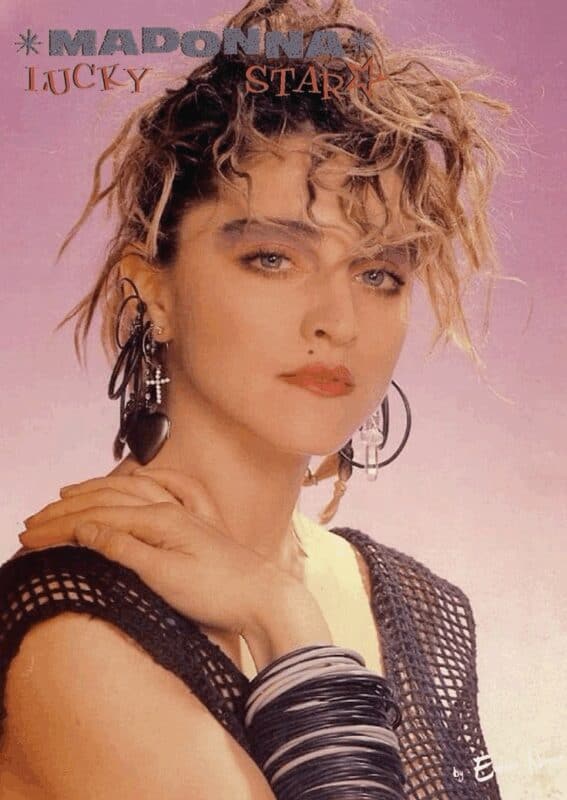
Credits: @Dressyouupinmylove / Pinterest
One of Madonna’s first breakthrough singles, “Lucky Star,” followed her debut EP and rode the momentum of disco-pop energy. It became a club favorite, firmly establishing her as pop royalty.
The song’s minimalist production—marked by shimmering synths and a catchy bass groove—paired perfectly with her aspirational lyrics, “You must be my lucky star.” I recall dancing to it at a friend’s basement party—even then, her star power felt immediate.
It was the sound of pop music evolving for the MTV era: dynamic, danceable, and visually driven.
Material Girl and Pop Persona
Few songs define an era like “Material Girl.” Released as a tongue-in-cheek critique of consumer culture, Madonna embraced the role with a wink and a smile.
The video drew visual inspiration from Marilyn Monroe’s Diamonds Are a Girl’s Best Friend, complete with glamorous props and corseted styling—a nod to fashion and celebrity iconography.
She mimicked Monroe’s iconic truck-loading scene while proclaiming she was “living in a material world.”
“Material Girl” was more than a chart success—it was a bold statement on image, agency, and fame. It came wrapped in leather jackets, fishnet stockings, and Jean Paul Gaultier-designed bustiers—symbols of self-expression and feminist identity.
Madonna didn’t just adopt the material worldview—she reclaimed it and used it to challenge gender expectations. The song’s layered meaning still resonates today.
La Isla Bonita: A Global Pop Sound
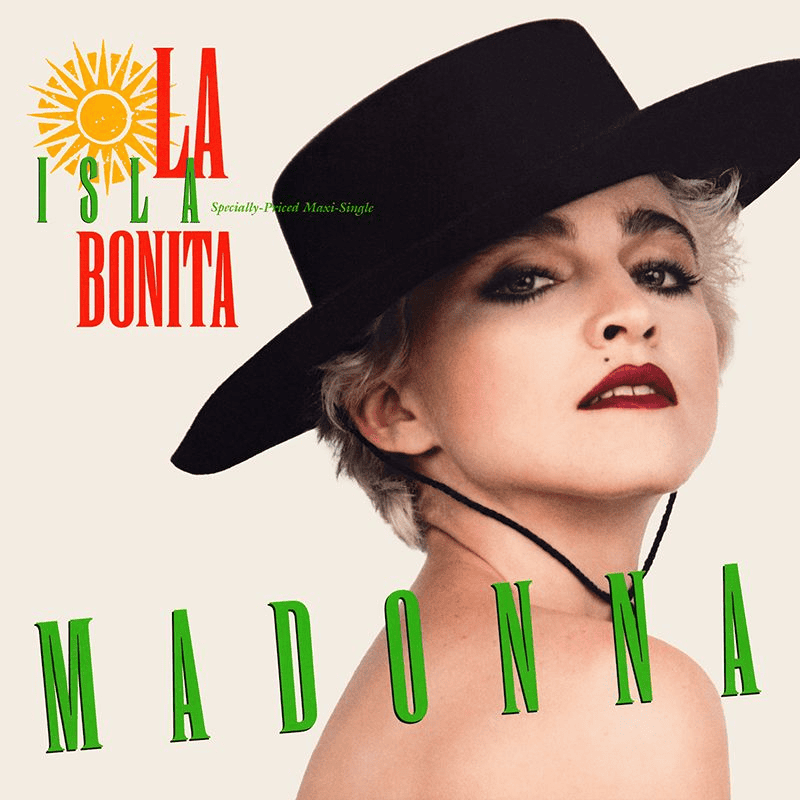
Credits: @bietz / Pinterest
By 1987, Madonna was breaking sonic barriers. “La Isla Bonita” showcased her embrace of Latin influences, complete with Cuban drums, Spanish guitar, maracas, and whispered Spanish lyrics.
It reached number one in the UK and topped Billboard’s Adult Contemporary chart—a first for her. This breezy, exotic ballad introduced her voice to broader audiences and helped bring Latin-pop to mainstream radio.
I remember hearing it on repeat during a summer road trip—it felt like it transported you to another world. When Madonna performed it on her Celebration Tour, she reminded everyone she pioneered pop’s global reach.
True Blue: Title Track and Timeless Love
The title track of her third album, True Blue, radiated retro charm and became emblematic of her career. With 1960s girl-group vibes—Motown horns, layered harmonies—it reflected her evolving persona.
Madonna wrote it for her then-husband Sean Penn, calling it an “unabashed valentine.” The video, set in a 1950s-style diner with Madonna in casual denim, gave fans an intimate glimpse into her love life—even as it played on big screens worldwide.
Dominance on Adult Contemporary
Songs like “La Isla Bonita” and the heartfelt ballad “Live to Tell” cemented Madonna’s crossover success into adult contemporary charts.
Her versatility let her thrive both as a club queen and an emotional storyteller—expanding her fan base across generations.
Both “La Isla Bonita” and “Live to Tell” topped Billboard’s Adult Contemporary chart—showcasing her emotional range and mainstream reach.
If I had to pick one favorite from her rise, it would be “Material Girl.” It’s more than a hit—it defines an image, a moment, a mood. Her swagger, Monroe-inspired visuals, and unapologetic control shaped her “queen of pop” persona like no one else.
But that’s just my take. Some fans love the uplifting nostalgia of “Lucky Star.” Others prefer the global sound of “La Isla Bonita” or the sincerity of “True Blue.” Each song reveals a different part of Madonna’s evolution.
Madonna’s Bold Fashion and Style
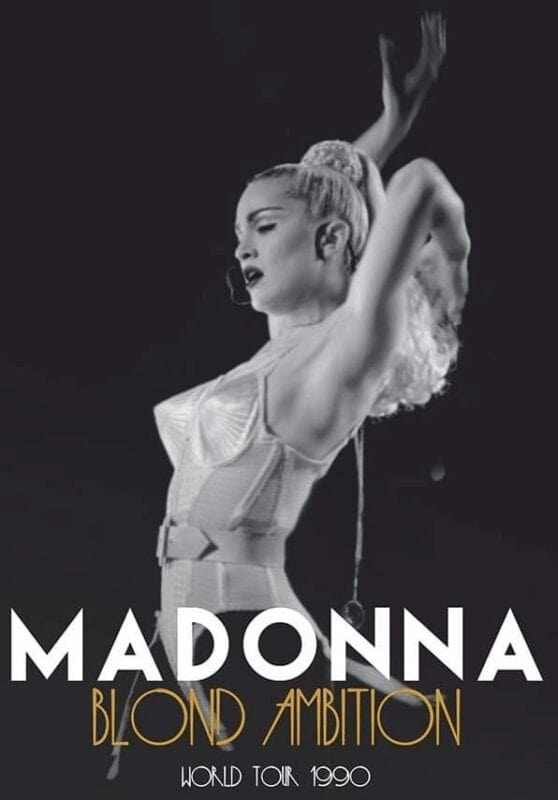
Credits: @elenaguiggi / Pinterest
Madonna’s bold fashion choices became as iconic as her music. Her style helped define her image and solidified her status as a fashion icon through daring looks, striking visuals, and cultural commentary.
Leather Jackets, Fishnet Stockings, and Mini Skirts
Madonna brought a rebellious edge to pop stardom. Leather jackets, fishnet stockings, and mini skirts became her trademarks. She merged street fashion with a polished pop sensibility.
I remember seeing her lean against a graffiti-covered wall in a music video and realizing the dance floor had a new dress code.
Signature Statement Pieces
Her look stood out with iconic accessories like black corsets, fingerless gloves, and layered pearl necklaces. These bold items expressed her powerful femininity and unshakable confidence.
That era wasn’t about subtlety—it was about owning your look with attitude.
Wearing these pieces wasn’t just about fashion—it was about performing identity.
Collaboration with Jean Paul Gaultier and Hints of Marie Antoinette
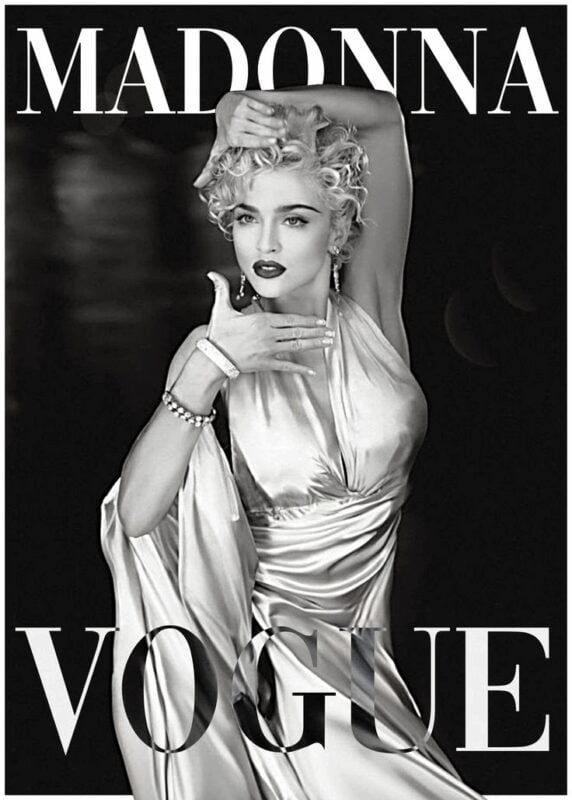
Credits: @coldazhellofc / Pinterest
Madonna teamed up with Jean Paul Gaultier to create unforgettable moments. He designed her cone bras and corseted ensembles—symbols of empowerment and high fashion.
Later, during her Vogue performance, she channeled Marie Antoinette’s opulence with ornate gowns and 18th-century flair. These performances fused high fashion with pop spectacle, influencing generations of designers and performers.
Blending Fashion Worlds and Eclectic Style
She blended streetwear with couture—pairing leather jackets with pearls and lace gloves—to create a look that was both grounded and aspirational. This eclectic mix showed that pop music could bridge fashion worlds.
Madonna proved that pop stars didn’t have to follow trends—they could set them.
Her fashion wasn’t an afterthought. It was a core part of her pop impact. From the leather and lace of early MTV videos to couture stagewear, she created entire worlds through style—echoing through every runway, red carpet, and pop video that followed.
Her Music Videos and Live Performances
Madonna’s fashion evolved into bold visual statements, but it was how she performed that truly cemented her legacy. Her music videos and live shows weren’t just entertainment—they were cultural events.
Music Videos That Changed Everything
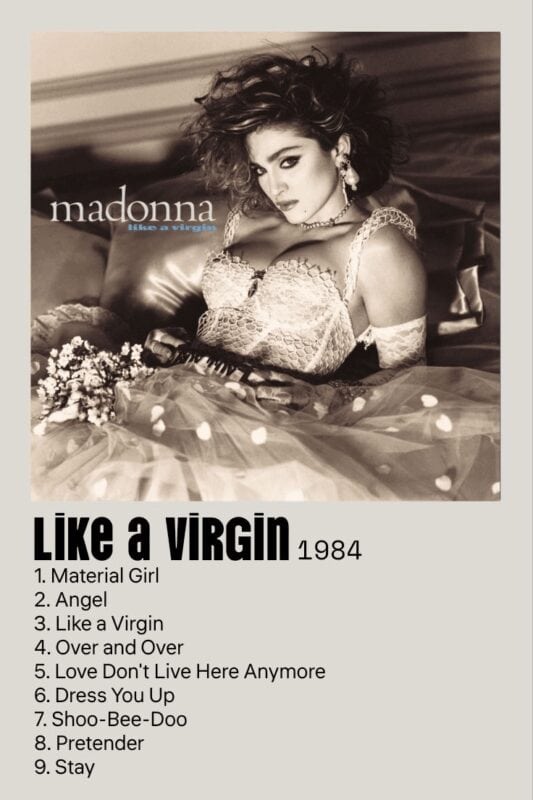
Credits: @mirandistaforever / Pinterest
Madonna turned music videos into an art form. In the early 1980s, MTV was new and experimental. While others were still figuring it out, Madonna mastered it.
Early videos like Lucky Star and Borderline introduced her style and attitude, but Like a Virgin and Material Girl showed her power to combine storytelling with emotional punch.
In Material Girl, she paid homage to Marilyn Monroe—pink gowns, choreographed dancers, glamour galore. But unlike Monroe, Madonna made it clear she was in control. It wasn’t about beauty—it was about power.
Later videos like Open Your Heart and Express Yourself grew more cinematic. In Express Yourself, she played a commanding leader in a dystopian world—breaking down gender roles and flipping visual expectations.
At the time, it was one of the most expensive music videos ever made—and it proved Madonna’s visual influence extended beyond music.
Each video deepened her connection with fans. She wasn’t just singing—she was performing narratives about love, identity, freedom, and power.
Iconic MTV Video Music Awards Moments
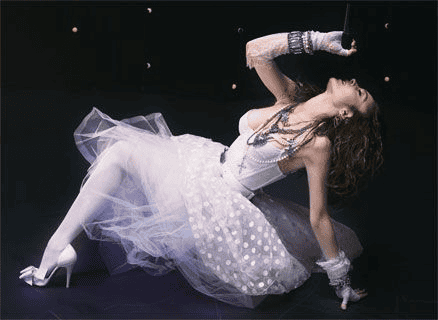
Credits: @glamourmag / Pinterest
The MTV Video Music Awards were practically built for Madonna. Her first time performing at the 1984 VMAs made headlines around the world. Wearing a wedding dress, a pearl necklace, and fingerless gloves, she sang “Like a Virgin” while crawling across the stage. It was shocking, theatrical, and unforgettable.
Year after year, she used the VMAs to make a statement. Whether it was her steamy 2003 kiss with Britney Spears or her “Vogue” performance in full Marie Antoinette dress, she turned each appearance into a moment.
These performances shaped what people expect from pop stars today. The line between music and spectacle got thinner, and Madonna was the one blurring it.
Challenging Traditional Gender Roles
Madonna used performance and fashion to challenge long-held gender norms. She blurred the lines between masculine and feminine—leather jackets and corsets, lace gloves and bold makeup.
Her outfits weren’t just stylish—they were political.
She proved women in pop didn’t need to play it safe. They could be provocative. They could lead. From music videos to stage productions, Madonna pushed against limits of how women were expected to present themselves.
Defining Tours: The Blonde Ambition Era
No one toured like Madonna. Her Blonde Ambition Tour in 1990 changed the game. It wasn’t just a concert—it was a theatrical experience, layered with narrative, choreography, and fashion.
It included religious themes, sexual expression, and historical references. The cone bra designed by Gaultier became a cultural symbol—bold, edgy, and unforgettable.
Producer Patrick Leonard helped shape the tour’s musical vision, setting a new standard for pop concert production.
Future tours like Hard Candy and Celebration followed this blueprint. But Blonde Ambition set the model: high-concept, high-fashion, and high-impact.
Madonna didn’t just perform—she reinvented performance itself. Her music videos, award-show moments, and stadium tours were the foundation of her legacy as a performer, fashion icon, and queen of pop.
And they continue to shape today’s pop stars.
Madonna’s Lasting Impact
Madonna didn’t just define the 1980s—she transformed the way we experience pop. Her fearless lyrics, bold visuals, and groundbreaking performances set a new standard that artists still follow.
The first time I saw her dancing across the screen in Lucky Star, I knew she was building something bigger than a hit—she was creating a cultural moment.
Her influence isn’t just about charts and headlines—it’s about inspiration. You can see her style, storytelling, and stage presence in artists like Justin Timberlake, who once collaborated with her on 4 Minutes.
From his choreography to his pop/R&B fusion, her impact is undeniable.
Madonna also reshaped the dance floor. Before her, music, fashion, and performance were separate. She fused them into something new—something unforgettable.
And she’s not finished. With her Celebration Tour drawing massive crowds and glowing reviews, Madonna continues to prove why she earned the title Queen of Pop.
Her legacy lives on in every daring pop anthem, every fashion-forward performer, and every artist unafraid to challenge the norm.
